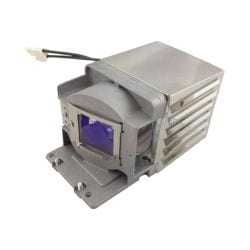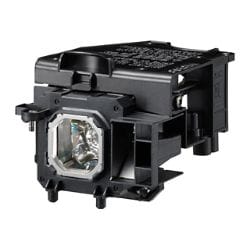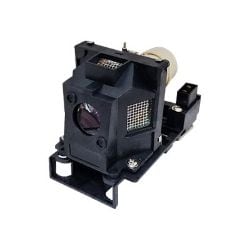July 14, 2022
Guide to Projector Lamp Replacement
In this guide we discuss how to tell when it's time for a replacement and ways to increase the life expectancy of your new projector lamp bulb.
Incompatible parts and mishandling can reduce the life-cycle of projector lamps and replacing them can be costly. It’s essential to understand how to choose the correct replacement. In this guide to projector lamp replacement, we’ll discuss how to tell when it's time for a replacement and ways to increase the life expectancy of your new projector lamp bulb.
How to Tell When to Change a Projector Bulb
Most projector lamps last between 1,500 and 2,000 hours, but some can last up to 5,000 hours. Most projectors will need one to two bulb swaps during this time.
Unlike other bulbs that go out once expended, the high-pressure mercury and xenon used in projector lamps cause bulbs to dim over time. Once the lamp light is at about half its original luminescence, it’s time to replace it. You can continue to use the bulb until complete failure, but doing so impacts image quality.
Check how many useful hours your lamp has left in the menu options of the projector. User manuals have specific steps for this process.
Manufacturers and product testers judge life expectancy based on a bell curve of a bulb. Most projector lamps come with a 90-day or 3-month warranty instead of a warranty that reflects its rated life span.

Lamp Replacement Options
The easiest way to get a compatible bulb is to buy an original equipment manufacturer (OEM) projector lamp replacement module designed for the projector model in question. Some companies make copy bulbs for cheaper alternatives. You can get a bare projector lamp without the housing and refurbish the existing housing and there are minimal risks in doing so.
OEM Lamp Modules
A lamp module includes a plastic heat-resistant housing, a bulb with a burner and reflector and projector connectors to secure the unit. Often, manufacturers reduce the cost of lamp modules to encourage users to use OEM replacement parts.
OEM parts often have life cycles more consistent with their expected ratings. They’re also a guaranteed fit and work with the projector as intended.
Lamp Copies
Third-party companies make generic bulb replacements dedicated to specific projector manufacturers. It makes it easier to determine if a lamp is compatible with your projector. They’re less expensive than OEM lamp modules, but not always as high-quality, leading to inconsistent life expectancies. It’s possible that using a non-OEM lamp will void a projector’s warranty, so read yours carefully before purchasing this type of replacement.
When choosing a non-OEM manufacturer, look for companies that produce lamps according to ISO9001 standards. Quality alternative manufacturers are also more likely to have lamp warranties.
Bare Lamps Without the Casing
Some projector users prefer projector bare bulb replacements without the casing. For this method, you’ll need to carefully remove the old bulb from the existing housing with a screwdriver and refurbish the case.
Note that lamp cages are not designed for disassembly and are often difficult to put back together.
Additionally, dust buildup on the case is very difficult to remove. If you leave any dust on the cage, it can lead to over-heating and cause the lamp to fail before its time.
To reduce possible damage, consider a new housing for bare bulbs.
Lumen Output
Lumens are the unit of measure used to measure the brightness of a light bulb. A standard classroom projector is rated for bulbs that produce between 1,000 and 1,200 lumens. More powerful projectors, like projectors for larger offices can handle lumen outputs of 2,500 or more.
Ignition Type
Projector lamp ignitions use either mercury or xenon gas to fill the ARC electrical current to produce bright light. Xenon ignitions are often more expensive and shorter-lived than their mercury counterparts, but they produce higher-definition pictures.
Elliptical vs. Parabolic Reflectors
Elliptical and parabolic reflectors collect rays of light from the projector bulb and reflect it onto another surface like a screen or wall. Elliptical reflectors are a bit more efficient than parabolic ones and produce better pictures, but not by much. Because of the difference in their shape and size, elliptical and parabolic reflectors aren't interchangeable.
Lamp Voltage
Lamp voltage refers to the type and amount of current a lamp needs to operate. If you choose a bulb with a voltage rating that’s too low, the bulb won’t provide enough light. Overpowered lamps will work, but may cause overheating.
7 Ways to Get the Most Out of Your Projector Lamp Life
There are many ways to extend the lamp life of a projector. Use these guidelines to get the most out of your new lamp.
1. Operate No More Than 3 to 5 Hours at a Time
Extensive use without a cool down period can quickly reduce the life span of a projector and bulb. It's the fastest way to burn out your equipment.
2. Clean Intake Vents, Exhaust Vents and Air Filters Regularly
All projectors feature intake and exhaust vents to help reduce overheating, There are also air filters available to protect delicate circuitry from debris. Clean the vents and air filters as often as your user manual instructs or at least once every three months to ensure long-lasting operation.
3. Operate the Device in a Clean, Dust-Free Environment With Good Airflow
Dust can clog intake and exhaust vents and restrict airflow in circuitry which can lead to overheating. Whenever possible, only use a projector in dust-free areas. Clean surfaces before setting up or mounting your projector to reduce debris near your device. If you must use the projector in less-than-ideal conditions, clean the vents and air filters more often than suggested. It’s equally important to ensure you use the projector in open areas that improve airflow.
4. Avoid Frequent Power Cycles
Every time you turn on the projector, the lamp strikes and reshapes the electrodes which slowly reduces the bulb’s lifespan. It’s better to leave it running if you need to take short breaks over hours of use.
5. Handle Bulbs With Care
The shock of dropping or striking a lamp can cause damage to the filament and reduce the number of hours it works. Be careful when handling bulbs whether they’re mounted in the projector, encased in a cage or bare. Don’t touch the bulb while replacing it, either. Oil from your hands can transfer to the lamp resulting in uneven heating and premature lamp failure.
6. Give Projectors Time to Cool Down Before Unplugging Them
Outside of some portable units, most projectors need some time to cool down before they’re unplugged. Unless the user manual states otherwise, don’t unplug the device until the fan stops running. A complete cooldown usually takes about ten minutes.
7. Use Lamp Economy Mode
Some projectors have a lamp-economy mode designed to extend a lamp’s life by up to 6,000 hours. It does so by reducing the bulb’s brightness by 20%. Most people won’t notice the difference in lumen output.

Conclusion
When choosing your new bulb, select an OEM lamp, or compare specs to get a compatible replacement. This projector lamp buying guide can help you make the right choice.
Now that you know how to buy a projector lamp, why not start your search with CDW. We offer a full array of lamps and other projector accessories to help you meet your projector needs.



